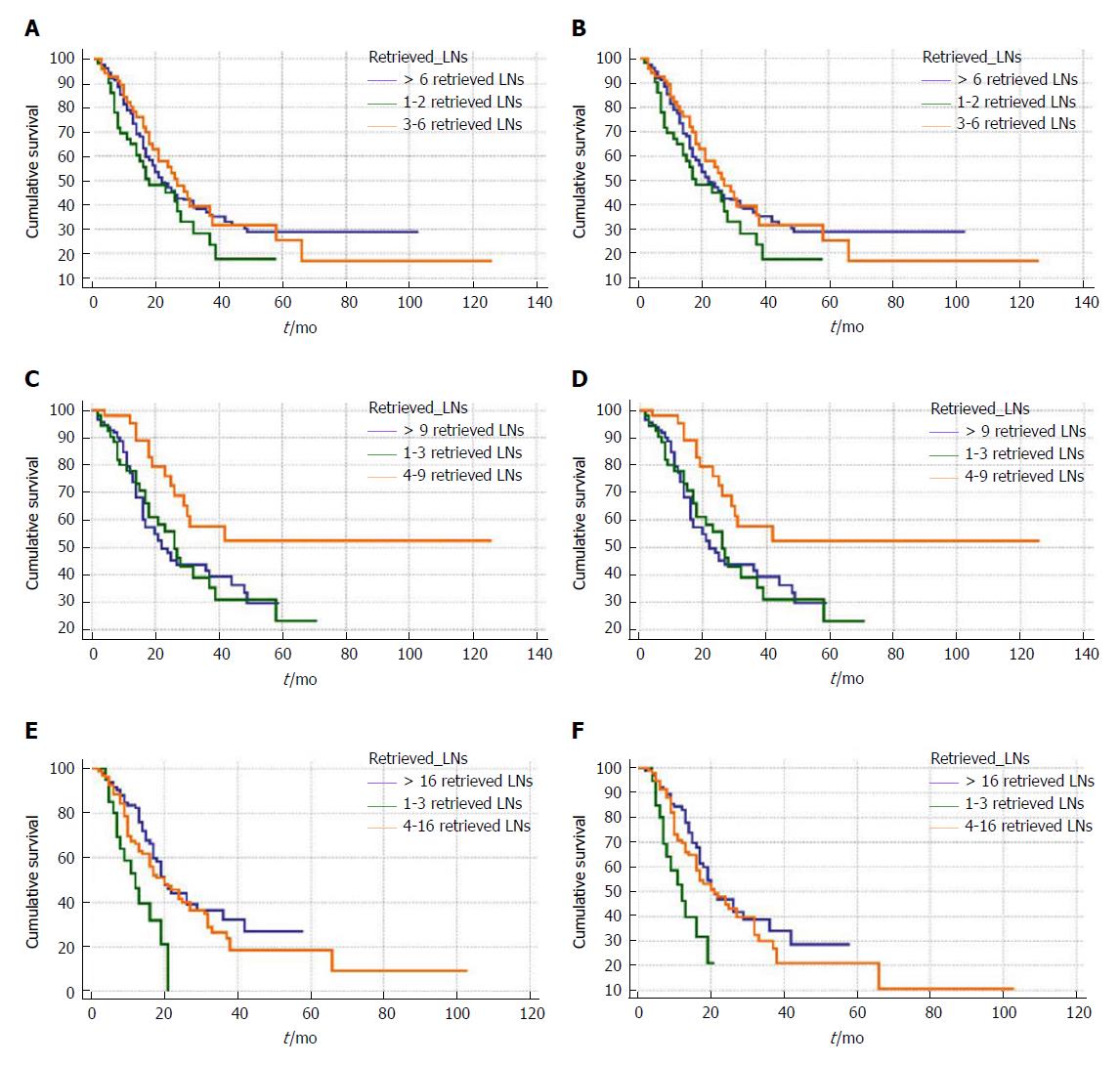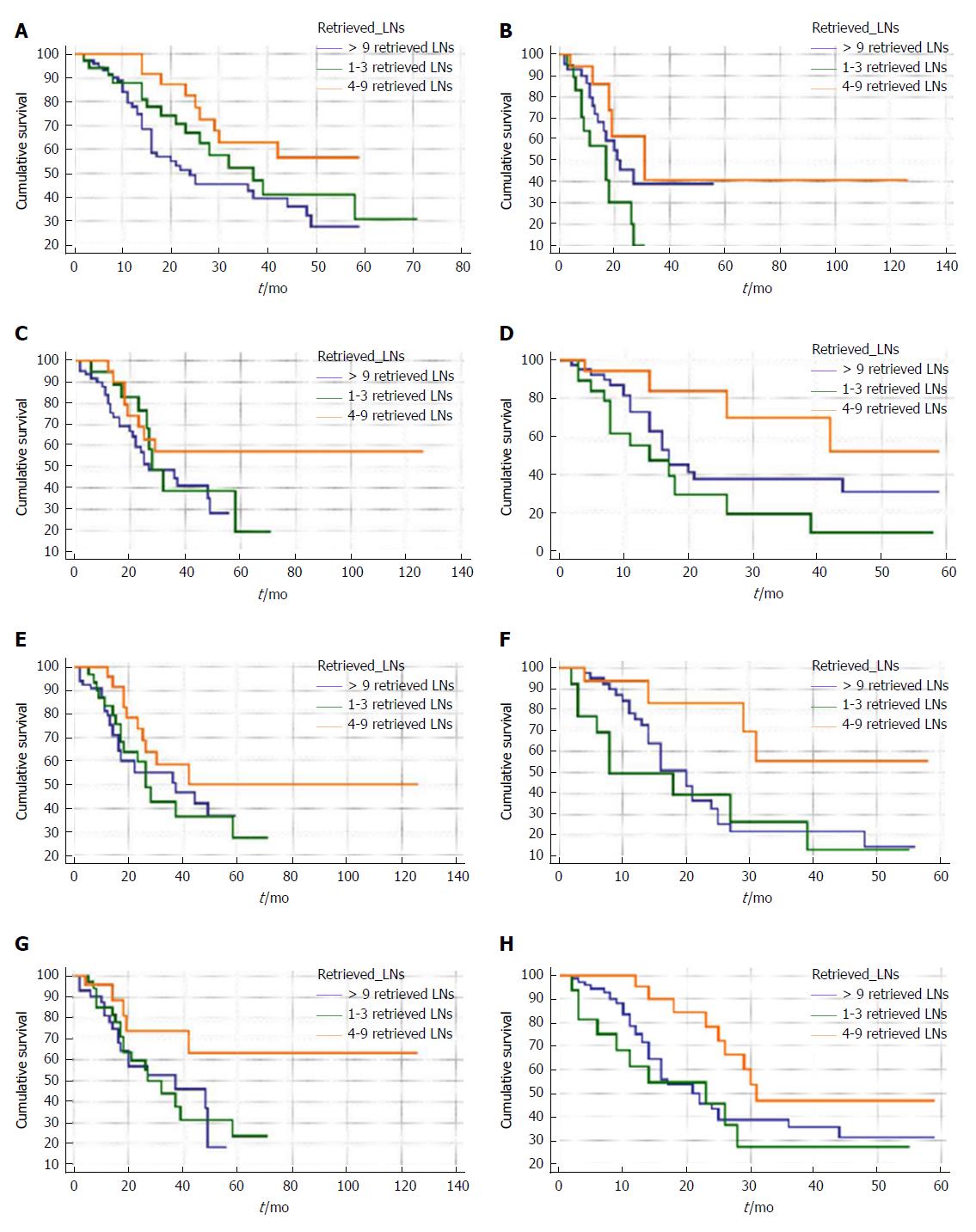Copyright
©The Author(s) 2018.
World J Gastroenterol. Mar 7, 2018; 24(9): 1022-1034
Published online Mar 7, 2018. doi: 10.3748/wjg.v24.i9.1022
Published online Mar 7, 2018. doi: 10.3748/wjg.v24.i9.1022
Figure 1 Kaplan-Meier survival curves of all patients in terms of (A) overall survival and (B) cancer-specific survival.
There was no significant difference in terms of overall survival (P = 0.233) and cancer-specific survival (P = 0.141) among the three groups. Kaplan-Meier survival curves of patients with node-negative distal cholangiocarcinoma in terms of (C) overall survival and (D) cancer-specific survival. Patients with four to nine retrieved LNs had a better overall (P = 0.026) and cancer-specific (P = 0.008) survival than patients with one to three retrieved LNs and patients with more than nine retrieved LNs. Kaplan-Meier survival curves of N1 patients in terms of (E) overall survival and (F) cancer-specific survival. There was no significant difference in terms of overall survival (P = 0.053) and cancer-specific survival (P = 0.0564) among the three groups. LNs: Lymph nodes.
Figure 2 Kaplan-Meier survival curves of stratified analyses in (A) patients ≤ 70-years-old, (B) > 70-years-old, (C) with tumors of ≤ 20 mm, (D) with tumors of 20 to 50 mm, (E) with tumors defined as well or moderately differentiated, (F) with tumors defined as poorly or undifferentiated, (G) with tumors of T1/T2 stage, and (H) with tumors of T3/T4 stage in terms of overall survival.
Patients with four to nine retrieved LNs had a significantly better overall survival than patients with one to three retrieved LNs and patients with more than nine retrieved LNs in the group of patients ≤ 70-years-old (P = 0.029), with tumors of 20 to 50 mm (P = 0.018), with tumors defined as poorly or undifferentiated (P = 0.030), and with tumors of T3/T4 stage (P = 0.041). LNs: Lymph nodes.
Figure 3 Kaplan-Meier survival curves of stratified analyses in (A) patients ≤ 70-years-old, (B) > 70-years-old, (C) with tumors of ≤ 20 mm, (D) with tumors of 20 to 50 mm, (E) with tumors defined as well or moderately differentiated, (F) with tumors defined as poorly or undifferentiated, (G) with tumors of T1/T2 stage, and (H) with tumors of T3/T4 stage in terms of cancer-specific survival.
Patients with four to nine retrieved LNs had a significantly better cancer-specific survival than patients with one to three retrieved LNs and patients with more than nine retrieved LNs in the group of patients ≤ 70-years-old (P = 0.025), with tumors of 20 to 50 mm (P = 0.0.006), with tumors defined as poorly or undifferentiated (P = 0.049), and with tumors of T3/T4 stage (P = 0.041). LNs: Lymph nodes.
- Citation: Lin HP, Li SW, Liu Y, Zhou SJ. Prognostic value of lymph nodes count on survival of patients with distal cholangiocarcinomas. World J Gastroenterol 2018; 24(9): 1022-1034
- URL: https://www.wjgnet.com/1007-9327/full/v24/i9/1022.htm
- DOI: https://dx.doi.org/10.3748/wjg.v24.i9.1022











